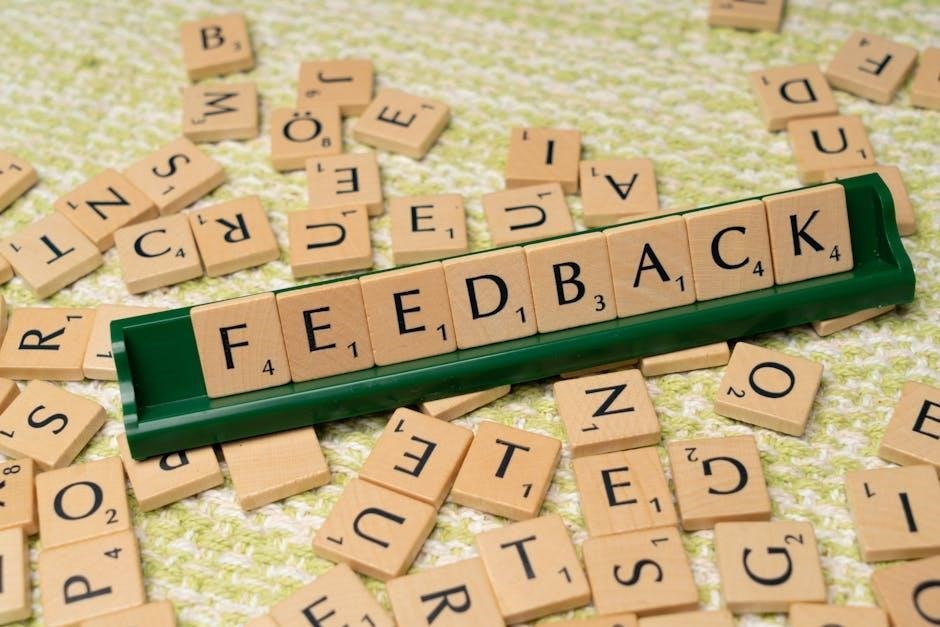The Outcome Rating Scale (ORS) is an ultra-brief measure assessing individual, interpersonal, and social functioning. Developed by Miller and Duncan (2000), it is a visual analog scale used to monitor therapeutic progress across sessions. The ORS is part of the Partners for Change Outcome Management System (PCOMS) and is suitable for adults, adolescents, and children, with adaptations like the Child ORS (CORS) for younger populations. Its simplicity and efficiency make it a widely used tool in clinical settings.

Development and History of the ORS
Developed by Miller and Duncan in 2000, the ORS emerged as a concise alternative to longer assessment tools. Designed for efficiency, it takes about one minute to administer and score, making it practical for regular use in therapeutic settings. Its creation aimed to provide immediate feedback on client progress, fostering collaborative therapy relationships.
2.1. Creation and Evolution
The Outcome Rating Scale (ORS) was created by Miller and Duncan in 2000 as a brief alternative to the Outcome Questionnaire 45.2. It was designed to be simple, efficient, and client-friendly. The ORS is part of the Partners for Change Outcome Management System (PCOMS), which also includes the Session Rating Scale (SRS). Over time, adaptations like the Child Outcome Rating Scale (CORS) for children aged 6-12 were developed, featuring visual aids like smiley faces. Validation studies involved over 3,000 participants, ensuring its reliability across diverse populations. The ORS has evolved to include electronic versions, making it accessible for modern clinical practices. Its design ensures quick administration and scoring, typically taking less than a minute per session.

Psychometric Properties of the ORS
The ORS demonstrates strong psychometric properties, with test-retest reliability ranging from 0.58 to 0.84. It exhibits good validity, effectively measuring individual, interpersonal, and social functioning changes in therapy.
3.1. Reliability
The Outcome Rating Scale (ORS) has demonstrated strong reliability across various studies. Test-retest reliability coefficients range from 0.58 to 0.84, indicating consistent measurement across administrations. This consistency is crucial for tracking therapeutic progress accurately. The ORS’s reliability is particularly robust when used session-by-session, making it a dependable tool for clinicians to monitor changes in client functioning. Its brevity and simplicity contribute to its reliability, ensuring that measurements remain consistent without burdening clients. Additionally, the ORS’s visual analog format aids in reducing variability, further enhancing its reliability. These findings suggest that the ORS is a reliable instrument for assessing therapeutic outcomes in diverse clinical populations.
3.2; Validity
The Outcome Rating Scale (ORS) has strong empirical support for its validity as a measure of therapeutic outcomes. Studies have shown that the ORS is sensitive to changes in client functioning over time, making it a valid tool for monitoring progress. It effectively assesses key areas such as individual well-being, interpersonal relationships, and social functioning. The ORS has been validated with diverse populations, including adults, adolescents, and children, and its results correlate well with longer outcome measures like the Outcome Questionnaire 45.2 (OQ-45.2). This equivalence in validity, despite its brevity, makes the ORS a practical choice for clinicians seeking to balance comprehensiveness with efficiency in outcome assessment.

Clinical Applications of the Outcome Rating Scale
The ORS is widely used in clinical settings to monitor progress, inform treatment decisions, and enhance client engagement by providing immediate feedback on therapeutic outcomes.
4.1. Use with Adult Populations
The Outcome Rating Scale (ORS) is widely utilized with adult populations due to its brevity and ease of administration, typically requiring only one to two minutes to complete. Its simplicity makes it accessible for individuals with a reading age of 13 and above, ensuring broad applicability. The ORS assesses four key areas of functioning: individual well-being, interpersonal relationships, social functioning, and overall life satisfaction. This makes it particularly useful for monitoring therapeutic progress in adults. Research has demonstrated strong reliability and validity in adult populations, with studies showing correlations between ORS scores and improvements in mental health outcomes. Additionally, the ORS is often used in conjunction with the Session Rating Scale (SRS) to provide a comprehensive feedback system, enhancing client engagement and treatment effectiveness.
4.2. Use with Adolescent Populations
The Outcome Rating Scale (ORS) is effectively used with adolescents aged 13-17, providing a developmentally appropriate tool for monitoring therapeutic progress. The scale’s visual format and simplicity resonate well with this age group, making it easier for adolescents to report their well-being. Research shows that over 3,000 adolescents participated in a four-year validation study, confirming the ORS’s reliability and validity for this demographic. The ORS assesses areas such as individual functioning, interpersonal relationships, and social interactions, which are critical during adolescence. Clinicians find the ORS particularly useful for engaging adolescents in their treatment process, as it allows for regular feedback and adjustments to therapy. This tool supports early identification of challenges and facilitates targeted interventions, enhancing overall treatment outcomes for adolescents.
4.3; Use with Child Populations
The Child Outcome Rating Scale (CORS) is specifically designed for children aged 6-12, adapting the ORS for younger populations. It uses simpler language and visual aids, such as smiley and frowny faces, to help children understand and complete the scale. This makes it more accessible and engaging for younger individuals. The CORS assesses similar domains as the ORS but in a developmentally appropriate manner. Clinicians find it useful for monitoring progress in therapy and identifying areas where children may need additional support. Validation studies have shown the CORS to be reliable and effective for this age group, making it a valuable tool in pediatric mental health care. Its visual and straightforward design facilitates easier communication between children and therapists, enhancing the therapeutic process.

Administration and Scoring of the ORS
The ORS is administered as a brief, session-by-session measure, typically taking less than a minute to complete. It utilizes a visual analog scale (0-10) across four domains: individual well-being, interpersonal relationships, social functioning, and overall life satisfaction. Clients rate their functioning in each area, with higher scores indicating better outcomes. The scale is simple to score, with total scores ranging from 0 to 40. An oral version is also available, using scripted questions to assess the same domains. The ORS is designed for individuals with a reading age of 13 or older, making it suitable for adolescents and adults. Its ease of use and quick administration make it a practical tool for monitoring therapeutic progress in clinical settings.

Comparison with Other Outcome Measures
The Outcome Rating Scale (ORS) stands out for its brevity and efficiency compared to longer instruments like the Outcome Questionnaire 45.2 (OQ-45.2). While the OQ-45.2 assesses similar domains, the ORS condenses these into a simpler, four-item scale, making it quicker to administer and score. Unlike the Patient Health Questionnaire (PHQ-9), which focuses solely on depression, the ORS provides a broader assessment of functioning. It also differs from the Generalized Anxiety Disorder 7-item scale (GAD-7) by encompassing social and interpersonal aspects. The ORS strikes a balance between comprehensiveness and practicality, offering a reliable and valid alternative for monitoring therapeutic progress without the burden of lengthy assessments.

Cultural Adaptations and Translations
The Outcome Rating Scale (ORS) has been translated into multiple languages to accommodate diverse populations. Available translations include Spanish, French, German, Italian, Portuguese, Dutch, Swedish, Norwegian, Danish, Finnish, Russian, Hebrew, Arabic, Turkish, Greek, Japanese, Korean, Chinese, Vietnamese, and Thai. These translations maintain the original structure and ease of use, ensuring cross-cultural applicability. Additionally, oral administration scripts are provided for populations with varying literacy levels. The translations are distributed by Better Outcomes Now, ensuring accessibility for practitioners worldwide. This extensive reach underscores the ORS’s adaptability and commitment to cultural sensitivity, making it a valuable tool for mental health care across global settings.

Case Studies and Practical Examples
Case studies demonstrate the practical application of the Outcome Rating Scale (ORS) in diverse clinical settings. For instance, in adolescent therapy, the ORS effectively tracked progress in reducing symptoms of anxiety over 12 sessions. In child populations, the CORS facilitated engagement, with smiley faces helping a 7-year-old communicate emotional improvements. Adults with relationship issues reported enhanced interpersonal functioning, as evidenced by consistent ORS score increases. Group therapy settings also utilized the GSRS to monitor collective progress, showcasing the ORS’s adaptability. These examples highlight how the ORS’s brevity and visual design enable consistent, client-centered feedback, making it a versatile tool for monitoring therapeutic outcomes across age groups and treatment modalities.

Future Directions and Emerging Trends
Future directions for the Outcome Rating Scale (ORS) include expanding its digital integration and exploring AI-driven analytics to enhance real-time feedback. Researchers are investigating its use in teletherapy and mobile health platforms, ensuring accessibility for diverse populations. Additionally, efforts to develop culturally sensitive adaptations for global use are underway, reflecting its growing international adoption. Emerging trends also include integrating the ORS with machine learning to predict treatment trajectories and identify at-risk clients early. These advancements aim to maintain the ORS’s simplicity while leveraging technology to improve mental health outcomes worldwide.
The Outcome Rating Scale (ORS) has proven to be a versatile and effective tool for monitoring therapeutic progress across diverse populations. Its brevity, simplicity, and ease of administration make it a valuable resource for clinicians seeking to enhance client outcomes. The ORS’s ability to provide real-time feedback fosters collaboration between clients and therapists, ensuring a client-centered approach. With adaptations for adults, adolescents, and children, the ORS demonstrates remarkable adaptability. Its integration into digital platforms and emerging trends in AI-driven analytics further underscore its potential to shape the future of mental health care. As a widely adopted measure, the ORS continues to play a pivotal role in improving treatment outcomes and advancing psychotherapy practices globally.
